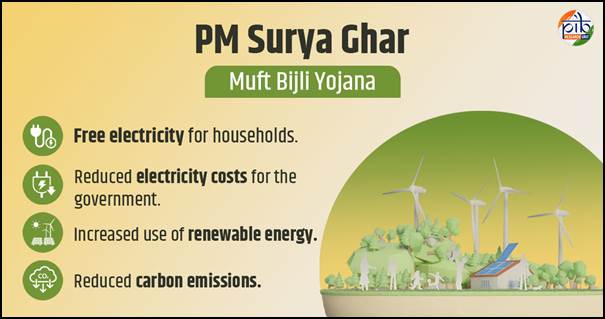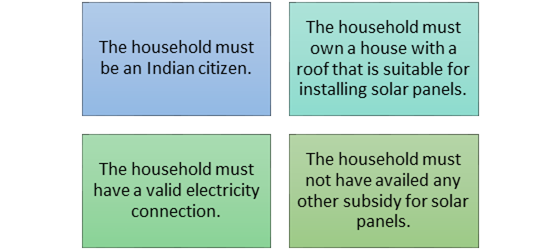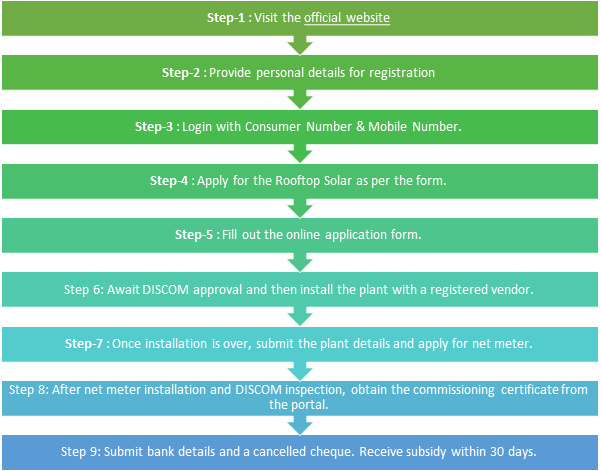Ministry of New and Renewable Energy
PM Surya Ghar: Muft Bijli Yojana - Redefining Solar Power and Energy Access
1.28 crore registrations and 14.84 lakh applications fuel India’s solar energy expansion
Posted On: 12 AUG 2024 5:28PM
Introduction
The PM Surya Ghar: Muft Bijli Yojana is a landmark initiative that was launched by Prime Minister Narendra Modi on February 15, 2024. It aims to transform India's energy landscape by providing free electricity to households. This ambitious scheme empowers households to harness solar energy by offering a substantial subsidy covering up to 40% of the cost of installing solar panels on their rooftops. By enabling widespread adoption of solar power, the scheme is poised to benefit 1 crore households across the country. Furthermore, it is projected to generate significant savings for the government, estimated at Rs. 75,000 crores annually in electricity costs. Through this initiative, the government underscores its commitment to promoting sustainable energy and ensuring energy access for all.
Key Benefits
The PM Surya Ghar: Muft Bijli Yojana offers several significant benefits to participating households:
- Free Electricity for Households: The scheme provides households with free electricity by installing subsidised rooftop solar panels, significantly reducing their energy costs.
- Reduced Electricity Costs for the Government: By promoting the widespread use of solar power, the scheme is expected to save the government an estimated ₹75,000 crore annually in electricity costs.
- Increased Use of Renewable Energy: The scheme encourages the adoption of renewable energy sources, contributing to a more sustainable and environmentally friendly energy mix in India.
- Reduced Carbon Emissions: The transition to solar energy under this scheme will help lower carbon emissions, supporting India's commitment to reducing its carbon footprint.
Subsidy Details
The subsidy provided under the scheme varies based on the household's average monthly electricity consumption and the corresponding suitable rooftop solar plant capacity:
|
Average Monthly Electricity Consumption (units)
|
Suitable Rooftop Solar Plant Capacity
|
Subsidy Support
|
|
0-150
|
1-2 kW
|
₹ 30,000/- to ₹ 60,000/-
|
|
150-300
|
2-3 kW
|
₹ 60,000/- to ₹ 78,000/-
|
|
> 300
|
Above 3 kW
|
₹ 78,000/-
|
Subsidy Application and Vendor Selection: Households can apply for the subsidy through the National Portal, where they can also select a suitable vendor for installing rooftop solar. The National Portal will assist in decision-making by providing information on appropriate system sizes, a benefits calculator, vendor ratings, and other relevant details.
Collateral-Free Loans: Households will have access to collateral-free, low-interest loans at around 7% interest for installing residential rooftop solar (RTS) systems up to 3 kW.

Eligibility

Application Process
The application process follows nine steps to ensure a smooth and efficient submission and approval of solar panel installation.

As of July 23, 2024, the scheme has received 1.28 crore registrations and 14.84 lakh applications, supported by 6,552 registered vendors across the country.
Impact
The PM Surya Ghar: Muft Bijli Yojana is expected to have far-reaching outcomes, both for individual households and the nation as a whole:
- Household Savings and Income Generation: Households will benefit from significant savings on their electricity bills. Additionally, they will have the opportunity to earn extra income by selling surplus power generated by their rooftop solar systems to DISCOMs. For instance, an average 3-kW system can generate over 300 units per month, providing a reliable energy source and potential revenue.
- Expansion of Solar Capacity: The scheme is projected to add 30 GW of solar capacity through rooftop installations in the residential sector, significantly contributing to India's renewable energy goals.
- Environmental Benefits: Over the 25-year lifetime of these rooftop systems, it is estimated that the scheme will generate 1000 BUs of electricity while reducing CO2 emissions by 720 million tonnes, making a substantial positive impact on the environment.
- Job Creation: The scheme is also expected to create approximately 17 lakh direct jobs across various sectors, including manufacturing, logistics, supply chain, sales, installation, operations and maintenance (O&M), and other services, thereby boosting employment and economic growth in the country.
Model Solar Village
Under the "Model Solar Village" component of the scheme, the focus is on establishing one Model Solar Village per district throughout India. This initiative aims to promote solar energy adoption and empower village communities to achieve energy self-reliance. An allocation of ₹800 crore has been designated for this component, with ₹1 crore provided to each selected Model Solar Village.
To qualify as a candidate village, it must be a revenue village with a population of over 5,000 (or 2,000 in special category states). Villages are selected through a competitive process and evaluated on their overall distributed renewable energy (RE) capacity six months after being identified by the District Level Committee (DLC).
The village in each district with the highest RE capacity will receive a central financial assistance grant of ₹1 crore. Under the supervision of the DLC, the State/UT Renewable Energy Development Agency will oversee the implementation, ensuring these model villages successfully transition to solar energy and set a benchmark for others across the country.
Conclusion
The "PM Surya Ghar: Muft Bijli Yojana" represents a transformative step in India's sustainable energy and economic empowerment journey. By providing substantial subsidies for rooftop solar installations, the scheme promises to significantly reduce household electricity costs and contributes to the government's broader goal of enhancing renewable energy use and cutting carbon emissions. With 1.28 crore registrations and over 14 lakh applications received with substantial financial outlay for initiatives like the Model Solar Village, the scheme demonstrates a robust commitment to fostering energy independence and environmental stewardship. The expected solar capacity expansion, job creation, and environmental benefits underscores the scheme's potential to drive long-term positive change. As India progresses with this ambitious initiative, it will undoubtedly set a precedent for solar energy adoption and inspire similar efforts globally.
References:
.https://x.com/FinMinIndia/status/1815636683884462566
· https://pib.gov.in/PressReleasePage.aspx?PRID=2010133
· https://pib.gov.in/PressReleasePage.aspx?PRID=2005596
· https://www.myscheme.gov.in/schemes/pmsgmb
· https://www.pmsuryaghar.gov.in/whatIsNew
.https://cdnbbsr.s3waas.gov.in/s3716e1b8c6cd17b771da77391355749f3/uploads/2024/08/2024080998431910.pdf
Click here to see in PDF:
Santosh Kumar/ Ritu Kataria/ Saurabh Kalia
(Backgrounder ID: 152016)
Visitor Counter : 146